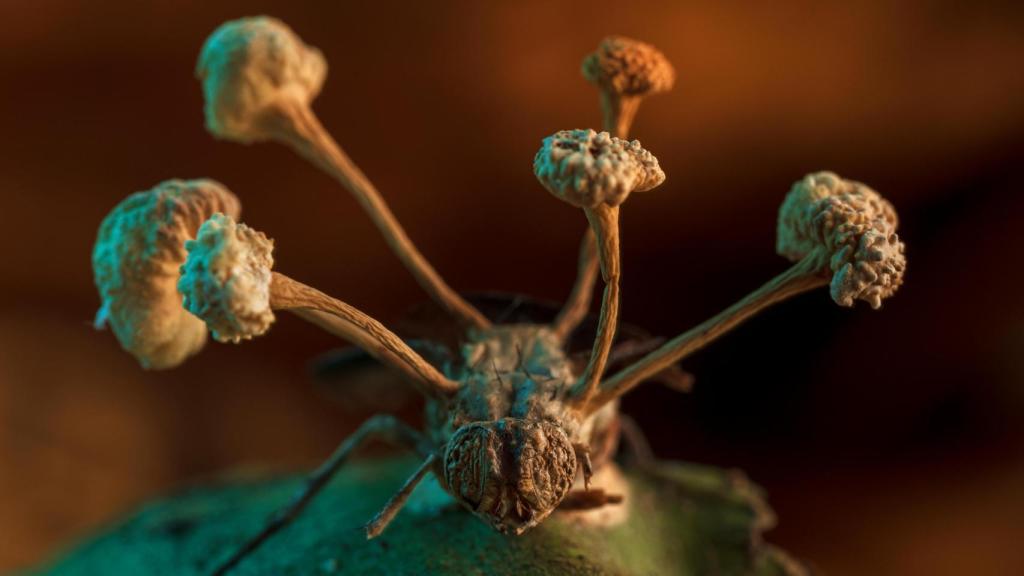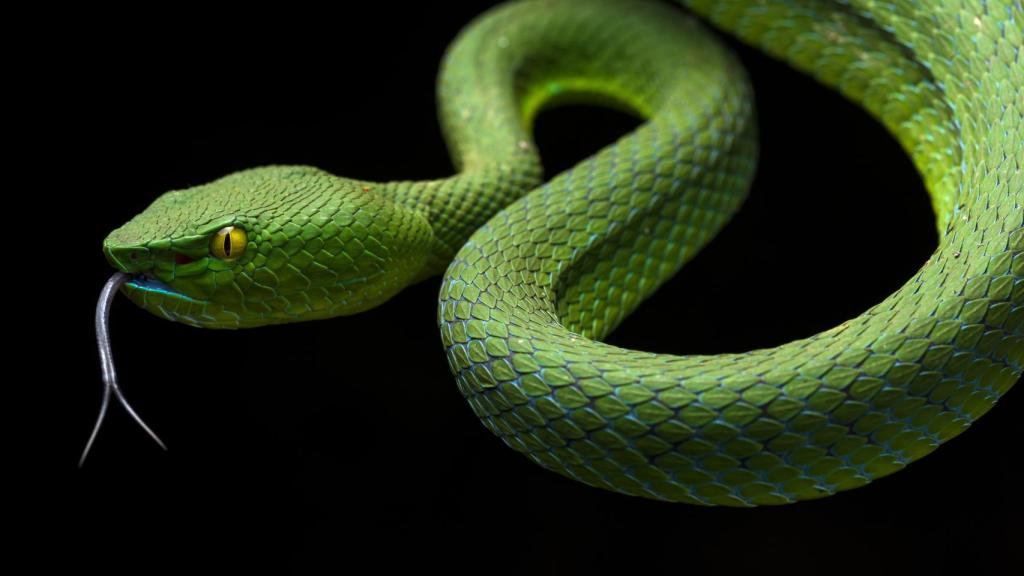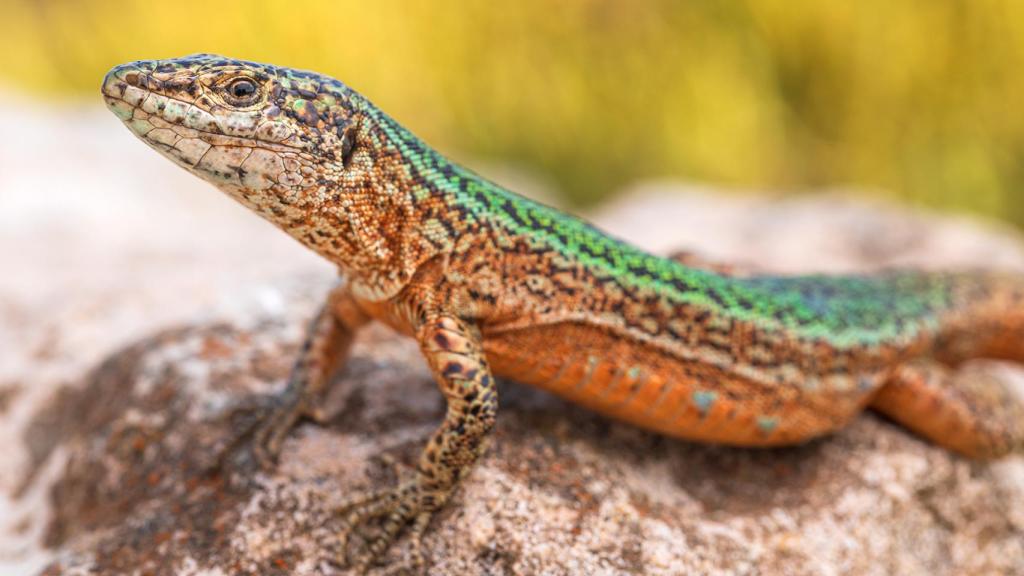It was hours of a night walk through the Peruvian jungle. Robert Garcia Roa (Madrid, 1984) had seen insects colonized by zombie fungi before, but the fly he found in the Tambopata National Reserve, in the southeastern region of the Andean country, was something spectacular: from its consumed body tree trunks seem to emerge in all directions, the tips of which are spores that will spread in search of the next victim.
“I ended up on the mites, I had them all over my body, including places you don’t want them to get,” the photographer and scientist admits to EL ESPAÑOL. But it was worth it: the image of the fly, like something out of a sci-fi movie, won him the magazine’s second international photography award BMC Ecology and Evolutionbelonging to the editorial group of Nature.
This is not the first award that García Roa has received thanks to beings from another planet. Last year the British Ecological Society awarded him for his images of Valenciolenda fadaforestaa kind of white bug with transparent wings as if surrounded by cotton.

The fly parasitized by zombie mushrooms in the Peruvian jungle that won him first prize in the competition.
To make this image, he didn’t have to go that far: the insect is found in some caves in Valencia, where this native of Madrid’s Carabanchel neighborhood went to live after being recruited by his university. Its peculiarity is that it was discovered only a few weeks ago and whose closest relatives are thousands of kilometers from the Iberian Peninsula.
“I took pictures of the females that hadn’t been taken yet; of the species that feed are hunted by spiders… It was a very nice case where the photo helped the scientific group that was investigating it to get more information,” he recalls.
It is no accident that he has won awards for photos of animals whose vision makes the hairs of mere mortals stand on end. This scientist and adventurer is determined to showcase these less graceful animals, misunderstood, hated and even feared species to make the public aware of the importance of their conservation and that of their environment.
[Frans De Waal, el Sabio de los Primates ‘Gais’ y ‘Trans’: “En Animales es Normal; los Intolerantes Somos Nosotros”]
“I’ve never been repulsed by insects. Ever since I was little, whenever I saw a spider or a cockroach, I was curious. Many companions such as eagles, wolves, etc. I was attracted to animals that do not attract much attention, even become scandalized, such as spiders, snakes, lizards or frogs.
And that means swimming against the current. “If you go to international nature photography competitions, most of the winning photos are usually of mammals, birds, situations with human beings… because they unconsciously attract more attention,” he admits. “Many people don’t know zombie mushrooms exist. They won’t be as aesthetically pleasing as an eagle on the hunt, but photographers have the resources to get striking images that pique the curiosity of those who see them.”

Photo of Adder Trimereserus sabahi taken in Malaysian rainforest.
Science photographer or science photographer? Roberto García Roa’s dual trajectory in science and art is intertwined. With a degree in biology from the University of Alcalá de Henares, he began to love the camera at the same time he was doing research.
“Before starting my PhD, I went to Nicaragua with the university in a collaborative project. There I realized that I wanted to show my friends and family what I was seeing but I couldn’t do it properly because my pictures were so bad then“.
These pictures also helped him relax during periods of stress while studying or working. “These pieces of jungle, mountains… The better the images, the easier it was for me to transport myself in space and time to Nicaragua, Argentina, Uruguay…”
[Enric Sala, el sabio de la naturaleza: “Que sólo estemos nosotros y las vacas es un suicidio colectivo”]
At the same time as he developed his career at CSIC or the University of Valencia, with a line of research focused on animal communication and its evolution in changing contexts, he made a name for himself as a photographer, publishing in iconic magazines such as National Geographic and as an ambassador for the Canon brand.
Multicolored lizards of the Balearic Islands
His two passions come together more than ever in his next project. This Friday, while his victory in the photography contest of BMC Ecology and Evolution Image Competition (also coinciding with World Photography Day), García Roa is packing his bags to leave for Sweden, where he will join the research group of Tobias Uhler and Nathalie Feiner at Lund University. They won a Marie Curie grant to study the evolution of color in the lizards of the Balearic Islands.
The scientific photographer laughs when told about the paradox of having to go to Sweden to study a species so close to his current home in Valencia. “This is the life of a researcher, at some point you have to leave Spain to continue studyingand this group is very powerful in its field: this scholarship is very difficult to obtain”.
The project consists of photographing the spectacular lizards of the archipelago, speckled with many colors, with a special camera that detects even the ultraviolet. “We will trace their evolutionary history, why they have more or less varied coloration, why some colors are more abundant than others… It connects my two worlds, photography and science, very well.”

The Balearic Lizard Podarcis pityusensis displays one of the many colors that this species can have throughout the archipelago.
When asked about a special place to appreciate biologically and photographically, he doesn’t hesitate. Experience in the jungles of Latin America and Asia, in the cold poles of Antarctica and, of course, in the spectacular Spanish caves – “cavemen come from all over the world because new species are constantly being described” – which he discovered as a result of not able to move out of the country due to Covid-19, García Roa chooses Morocco as the most surprising shooting environment.
“Human Being in the Middle of Nowhere”
“I recently did a project to visit abandoned cisterns where many animals fall and can starve to death,” he explains. “Goats, snakes, all kinds of insects. We’ll rescue them and photograph them.” Morocco, he affirms, “is a country with a very interesting biodiversity, the cities attract our attention, but there is incredible diversity.”
One last thing. Photographing snakes and spiders is fine, but many are dangerous because of their venom. Didn’t they scare you, not a single moment of tension? “Never,” he replies with aplomb. “You have to be very careful with snakes. Not everyone can go and photograph snakes and such when they are poisonous: you have to know them very well, know when the animal is afraid or calm… It is very rare that they bite and we do nothing to them, but there are people who hit them with a stick out of fear and although most will run away, they can protect themselves”.
Yes, there is an animal that gives you special respect. “When we meet big cats or mammals in the jungle, we know how they will react, but when you meet people in the middle of the jungle at night, there is tension. The animal that respects me the most is the man in the middle of the jungle “of nothing”.
Well, that and parasites. “They go unnoticed and they are the ones that worry us the most. The combination we have to watch out for is humans and parasites,” he says.